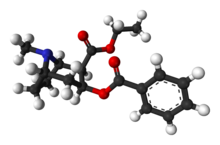Cocaethylene
 | |
 | |
| Clinical data | |
|---|---|
| Other names | benzoylecgonine ethyl ester, ethylbenzoylecgonine, |
| Pregnancy category |
|
| Routes of administration | Produced from ingestion of cocaine and ethanol |
| ATC code |
|
| Legal status | |
| Legal status |
|
| Identifiers | |
| |
JSmol) | |
| |
Cocaethylene (ethylbenzoylecgonine) is the
Metabolic production from cocaine
Cocaethylene is the byproduct of concurrent consumption of
- cocaine + H2O → benzoylecgonine + liver carboxylesterase 1)[4]
- benzoylecgonine + ethanol → cocaethylene + H2O
- cocaine + ethanol → cocaethylene + methanol (with liver carboxylesterase 1)[5]
Physiological effects
Cocaethylene is largely considered a
In most users, cocaethylene produces euphoria and has a longer duration of action than cocaine.[6][7] Some studies[8][9] suggest that consuming alcohol in combination with cocaine may be more cardiotoxic than cocaine and "it also carries an 18 to 25 fold increase over cocaine alone in risk of immediate death".[7] Cocaethylene has a higher affinity for the dopamine transporter than does cocaine, but has a lower affinity for the serotonin and norepinephrine transporters.[10][11]
In McCance-Katz et alia's 1993 study found that cocaethylene "produced greater subjective ratings of 'High' in comparison with administration of cocaine or alcohol alone."[6]
See also
- Ethylphenidate
- Euphoriants
- Methylvanillylecgonine
- Local anesthetics
- RTI-160
- Stimulants
- Tropanes
- Vin Mariani
- Pemberton's French Wine Coca
References
- ^ PMID 12485948.
- PMID 30796807.
- ^ * Doward J (8 November 2009). "Warning of extra heart dangers from mixing cocaine and alcohol". The Guardian.
- ^ "MetaCyc Reaction: 3.1.1". Retrieved 25 January 2016.
- ^ "MetaCyc Reaction: [no EC number assigned]". Retrieved 25 January 2016.
- ^ S2CID 25055492.
- ^ PMID 9243342.
- PMID 11229942.
- PMID 8371143.
- PMID 8857569.
- S2CID 6558411.
Further reading
- Morris J (19 April 2010). "Cocaethylene: responding to combined alcohol and cocaine use". Alcohol Policy UK.
- Landry MJ (1992). "An overview of cocaethylene, an alcohol-derived, psychoactive, cocaine metabolite". Journal of Psychoactive Drugs. 24 (3): 273–276. PMID 1432406.
- Hearn WL, Rose S, Wagner J, Ciarleglio A, Mash DC (June 1991). "Cocaethylene is more potent than cocaine in mediating lethality". Pharmacology, Biochemistry, and Behavior. 39 (2): 531–533. S2CID 36163843.
- Hearn WL, Flynn DD, Hime GW, Rose S, Cofino JC, Mantero-Atienza E, et al. (February 1991). "Cocaethylene: a unique cocaine metabolite displays high affinity for the dopamine transporter". Journal of Neurochemistry. 56 (2): 698–701. S2CID 35719923.
